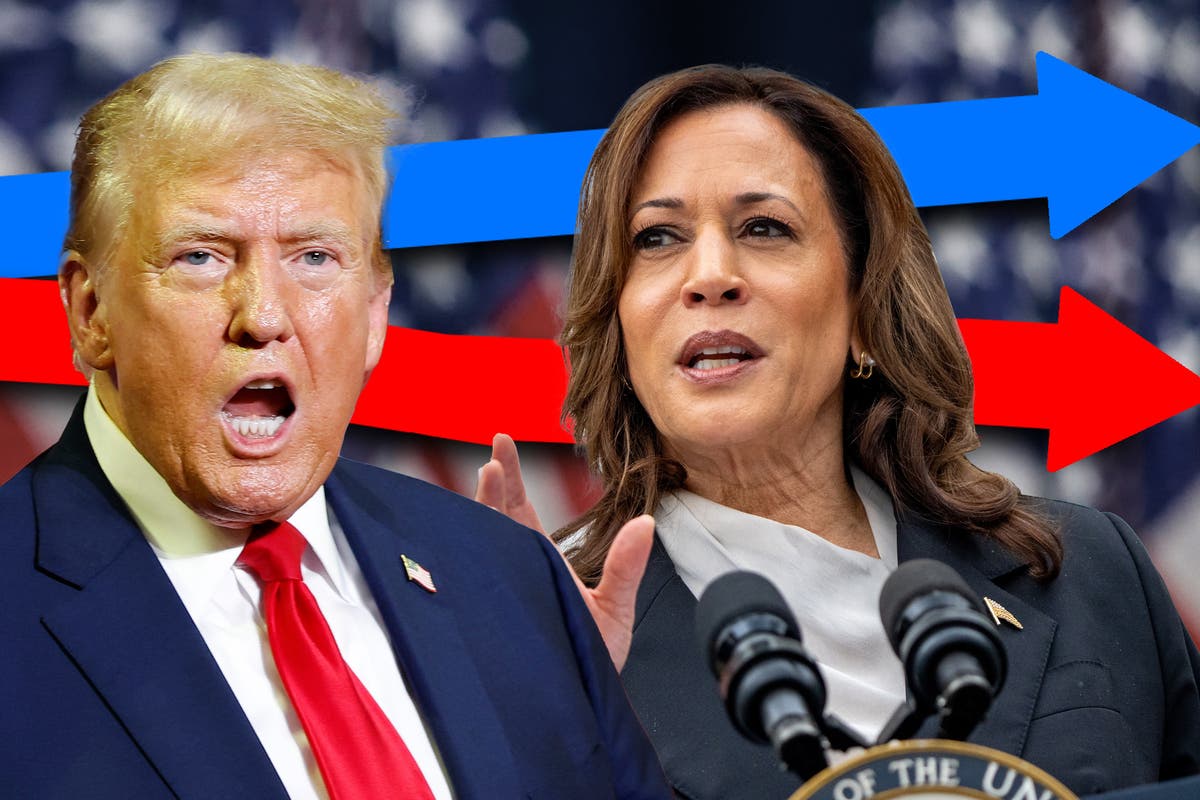World
Can Kamala Harris beat Donald Trump? Latest poll updates from the 2024 election

In just four days, Vice President Kamala Harris will go head-to-head with Donald Trump, as Americans cast their votes in the 2024 election.
With over 55 million voters already cast, early voting data is rolling in, but the national polls are still showing the two candidates in a deadlock.
Yet a new poll shows that Harris may have an edge in two major swing states, which will be crucial to get ahead in the electoral college.
Nearly 100 electoral votes are too close to call, and this could be the closest election in several decades.
So how will Harris and Trump fare next week?
The latest average of national polls, collated by FiveThirtyEight, shows Harris with a 1.2-point lead over Trump. On average, Harris was marginally ahead of Trump, but this gap has closed significantly over the last month.
A fresh set of polls from CNN and SSRS have suggested some more concrete leads in two battleground states, which have only become tighter in recent weeks.
The poll of likely voters found that Harris holds a 5-point lead over Trump in Michigan, with 48 percent to 43 percent.
In Wisconsin, the poll showed a 6-point lead for Harris.
Both of these results are just outside the margin of error, suggesting that Harris could carve out a small lead in those states next week.
In Pennsylvania, however, both candidates remain at a stalemate of 48 percent support each.
Pennsylvania, which has 19 electoral college votes, has been a major focus for both the Trump and Harris campaign in this election.
The candidates have made stops in the state multiple times a month, and billionaire Elon Musk’s dubious giveaway was designed to mobilise Pennsylvania voters.
Pennsylvania flipped to Trump in 2016, but President Biden regained his hometown state in 2020.
Both wins were within a few percent of each other, meaning that all eyes are on the state this year.
National deadlock
Polls published this week (since October 26) have mixed results, with Harris ahead in some, Trump taking the lead in others, and some showing a tie.
However, no polls are showing margins beyond a few points, outside of the margin of error, meaning that the candidates are in an effective deadlock.
This could spell bad news for the Democrats, who have won the popular vote in the last eight elections (excluding 2004, when George W Bush was re-elected).
Since the Republican Party enjoys an advantage in the Electoral College, such close national numbers may alarm the Harris campaign.
The Independent’s analysis of the Electoral College confirms that neither candidate can get over the line to 270 votes without the swing states.
On average, the polls in these states — Arizona, Georgia, Michigan, Wisconsin, Pennsylvania, North Carolina, and Nevada — show little advantage for either Harris or Trump.
According to state polling averages from FiveThirtyEight, the battlegrounds all have the candidates within 2 percent of each other, and as little as 0.3 percent apart.
These margins are so small that no winner can be reasonably projected until votes are cast.
Black voters
Despite little to no movement in the polls overall, one key group has shifted in the past month: black men under 50.
A fresh poll from the NAACP found that Black men have solidified their support for Harris, after a previous poll suggested nearly 3 in 10 would be voting for Trump.
According to the poll of 1,000 Black voters, support for Harris among men under 50 years old jumped from 51 percent last month to 59 percent now.
Support for Trump dropped from 27 percent to 21 percent in the same period.
Though there have been some suggestions that Black men are leaning towards Trump, this does not appear to be the case on a large scale; and moreover, this group represents only 6 to 7 percent of eligible voters, according to Pew Research.
However, the NAACP poll also shows that 73 percent of all Black voters support Harris; a far cry from 90 percent supporting Biden in 2020, and 93 percent for Obama in 2008.
This is up 10 percent from the NAACP’s same poll last month, but represents a degree of hesitation among a key demographic for the Democrats.
Demographics
The latest poll from HarrisX has Trump leading by +2 points, for the first time since July.
The poll of 1,512 voters found that 51 percent say they support Trump, with 49 percent for Kamala Harris, when including voters who are leaning one way or the other.
Unlike previous polls, which indicate a double-digit lead for Harris among younger generations, this poll suggests that young voters are divided among both candidates.
Women and Americans from non-white backgrounds show the strongest support for Harris, while white and male voters make up Trump’s key base.
The gender gap between both candidates, with more men supporting Trump and women supporting Harris, does not appear as drastic in this poll.
Key issues for swing voters
The economy has consistently topped the list of key issues for voters in this election.
The Washington Post poll of swing state voters also found that healthcare and threats to democracy topped the list of factors for deciding the next president.
Though Trump has advocated for overhauling Obamacare, with unsuccessful attempts during his presidency, he was unable to outline an alternative healthcare policy at the September presidential debate.
Immigration ranks highly as a deciding factor in this election, and exclusive polling for The Independent shows that the candidates’ immigration policies are of high importance to Latino voters.
Interestingly, climate change ranks lowest on the list of priorities for swing state voters this year.
Climate change has scarcely been on the agenda in this election, with Harris and Walz largely silent on the matter, and Trump-Vance actively perpetrating climate denial.
With the recent devastating hurricanes, climate change was once again brought to the forefront; though Trump incorrectly stated in a speech on October 1 that “the planet has actually gotten a little bit cooler recently.”
Red states
Fresh polls from Emerson College confirm that Trump is leading in the red states of Texas and Florida.
Trump’s 7- and 8-point leads (respectively) are weaker than forecasts earlier this year; yet the poll shows that women are backing Trump (49 percent) more than Harris (47 percent) in Florida, a success for the Republican campaign, which has been hemorrhaging votes from women across the country.
Though it appears very likely that both states will remain red, the Senate races are a different question.
In Texas, where former presidential hopeful Ted Cruz is defending his Senate seat, Democrat Colin Allred is just 1 point behind, leading to a virtual tiebreak.
This has been a point of concern for the GOP, according to an internal memo discussed below.
Texas independent voters favor Allred (47 percent) over Cruz (42 percent). In the presidential race, they’re leaning towards Trump over Harris, with a 2-point margin.
In Florida, incumbent GOP Senator Rick Scott is just 4 points ahead of Democrat Debbie Mucarsel-Powell, with 8 percent of voters still undecided.
GOP troubles in the Senate race
Republicans are now concerned about Senate elections, according to an internal polling memo obtained by Politico.
The memo reveals that, by the Republicans’ own polling, their candidates are trailing behind Democrats in seven out of nine key Senate seats, data that’s largely been confirmed by public polls. Those seats are in Arizona, Maryland, Michigan, Nevada, Ohio, Pennsylvania, and Wisconsin.
“We still have a lot of work to do to maximize our gains in this critical Senate election […] We also have to guard our flanks,” writes the memo’s author Steven Law, head of the Senate Leadership Fund.
The memo also warns that strongholds like Nebraska and Texas could be at risk from independent and Democratic candidates.
“We are putting everything we have into this fight — so there is no looking back with regret,” the memo ends.
Who will vote?
A YouGov/Economist poll has Harris with a three-point lead among registered voters, at 47 percent, and Trump at 44 percent. The poll shows a wide 25-point margin for Harris among young voters, aged 29 and under.
However, according to the same poll, the younger generations are also the least committed to voting, with 13 percent of the 18-29-year-olds surveyed saying they will “maybe” vote, while 3 percent will not vote or are still unsure.
This amounts to 16 percent who are on the fence or not voting, higher than any other age group, and higher than the average of 9 percent. Just 65 percent of the 18 to 29-year-olds polled said they would definitely vote in November.
This is in comparison to 77 percent of 30 to 44-year-olds, 85 percent of 45 to 64-year-olds, and 94 percent of the 65+ age group.
Though the numbers may seem dismal, and represent a degree of hesitancy among younger voters, the overall picture is significantly more engaged than in 2020.
The same YouGov/Economist poll at this stage in the 2020 presidential election showed that nearly a third of young people (27 percent) were not committed to voting in November, with 10 percent “maybe” voting and 17 percent “definitely/probably” not voting.









